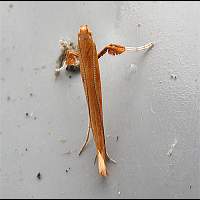Caloptilia betulicola
This moth might be called the Birch Leaf-mining Moth. It is a beautiful, but variable animal. You can best identify it by looking at the warm reddish brown color, the big trousers (the hairs on the legs, also referred to as the 'flag') and the long antennae. There is an extremely similar species though: the more common Caloptilia elongella. Its caterpillars however are found on alder, not birch. The two species may sometimes be told apart by looking at the series of characteristics just mentioned. Usually Caloptilia betulicola has antennae which are about the same length as the entire body and sometimes even longer. Its look-a-like always has slightly shorter antennae. However you can not always rely on this characteristic. To be sure, you have to dissect the animal and study its intimate parts under the microscope. We didn't do that. Thus we can not guarantee the species in the pictures actually is Caloptilia betulicola.
Like the scientific name of the species indicates this animal depends on birch for its caterpillars. When the larvae hatch they mine a leaf. This means they enter the leaf and live inside of it. The first instar eats a tiny, hardly visible mine. The next instar however more or less eats in circles, expanding the mine in all directions, thus making a blotch in the leaf. The manure is deposited in one heap in one corner of the mine. The second instar usually makes the blotch on the underside of a leaf. Blotches on the upperside do exist though. Later instars are too big to live inside a leaf. They get out and roll up a leaf, or just the edge of the leaf. Pupation takes place in a strong, shiny cocoon which is attached to the side of a leaf. Acording to some, Caloptilia betulicola prefers young birches, including (wild) shoots.
In most of Britain this species has two broods. The autumn generation is on the wing in October and November looking for a suitable place to overwinter. In March they start flying again and the eggs are usually deposited in April and May. In May we usually find great numbers of active caterpillars. In June there is little activity. The moths are dying and most caterpillars have pupated. In July and August the summergeneration is on the wing. The moth is attracted to light, but in extremely small numbers only. Mainly due to mix ups with the extremely similar Caloptilia elongella the exact status of Caloptilia betulicola is vague, but probably it is less common and a rather local species.
This moth might be called the Birch Leaf-mining Moth. It is a beautiful, but variable animal. You can best identify it by looking at the warm reddish brown color, the big trousers (the hairs on the legs, also referred to as the 'flag') and the long antennae. There is an extremely similar species though: the more common Caloptilia elongella. Its caterpillars however are found on alder, not birch. The two species may sometimes be told apart by looking at the series of characteristics just mentioned. Usually Caloptilia betulicola has antennae which are about the same length as the entire body and sometimes even longer. Its look-a-like always has slightly shorter antennae. However you can not always rely on this characteristic. To be sure, you have to dissect the animal and study its intimate parts under the microscope. We didn't do that. Thus we can not guarantee the species in the pictures actually is Caloptilia betulicola.
Like the scientific name of the species indicates this animal depends on birch for its caterpillars. When the larvae hatch they mine a leaf. This means they enter the leaf and live inside of it. The first instar eats a tiny, hardly visible mine. The next instar however more or less eats in circles, expanding the mine in all directions, thus making a blotch in the leaf. The manure is deposited in one heap in one corner of the mine. The second instar usually makes the blotch on the underside of a leaf. Blotches on the upperside do exist though. Later instars are too big to live inside a leaf. They get out and roll up a leaf, or just the edge of the leaf. Pupation takes place in a strong, shiny cocoon which is attached to the side of a leaf. Acording to some, Caloptilia betulicola prefers young birches, including (wild) shoots.
In most of Britain this species has two broods. The autumn generation is on the wing in October and November looking for a suitable place to overwinter. In March they start flying again and the eggs are usually deposited in April and May. In May we usually find great numbers of active caterpillars. In June there is little activity. The moths are dying and most caterpillars have pupated. In July and August the summergeneration is on the wing. The moth is attracted to light, but in extremely small numbers only. Mainly due to mix ups with the extremely similar Caloptilia elongella the exact status of Caloptilia betulicola is vague, but probably it is less common and a rather local species.





